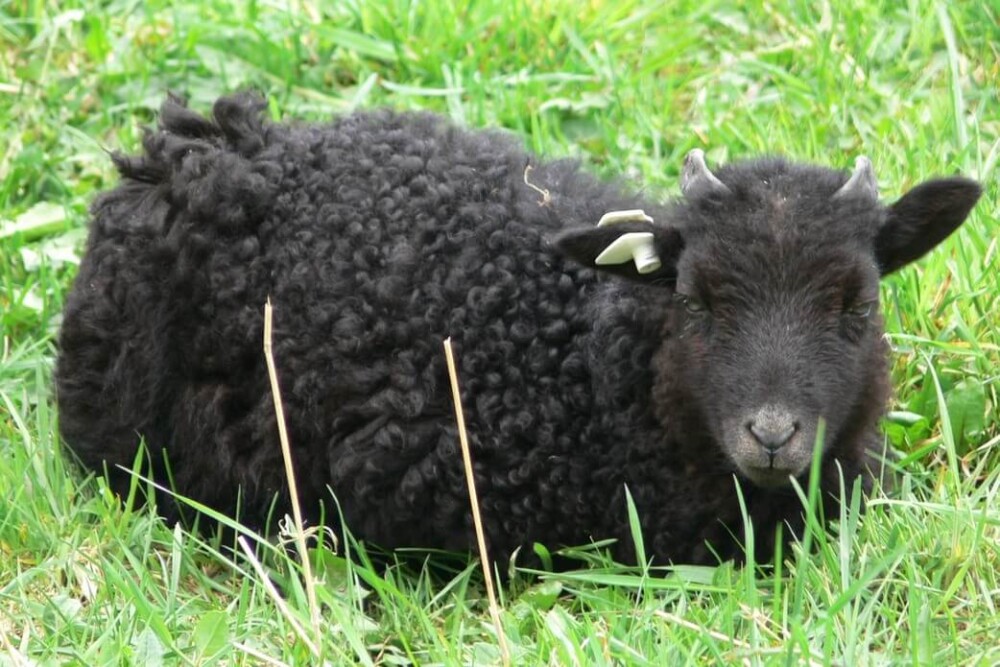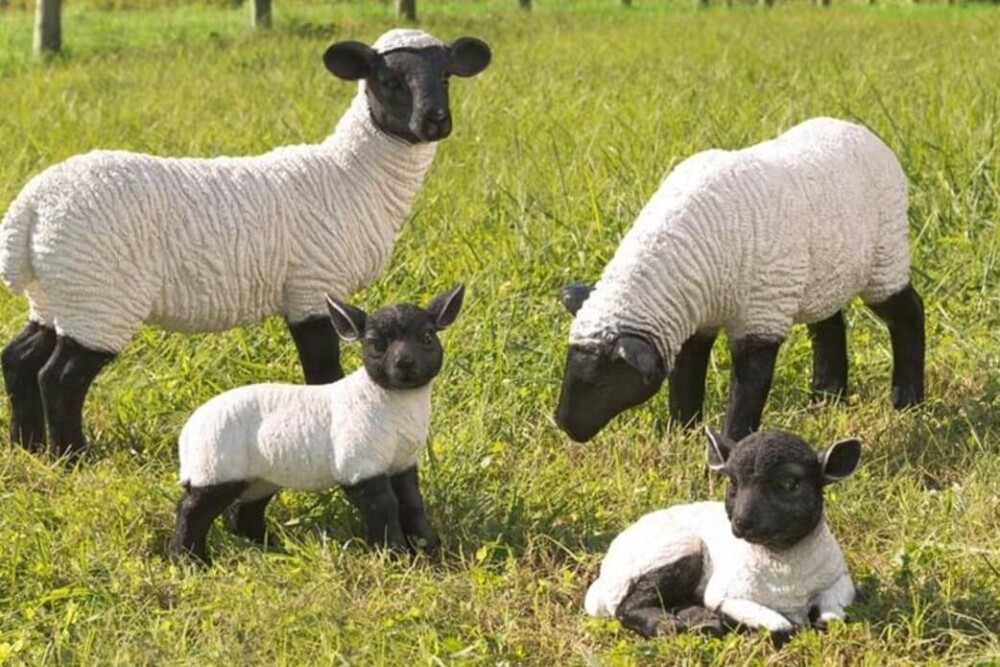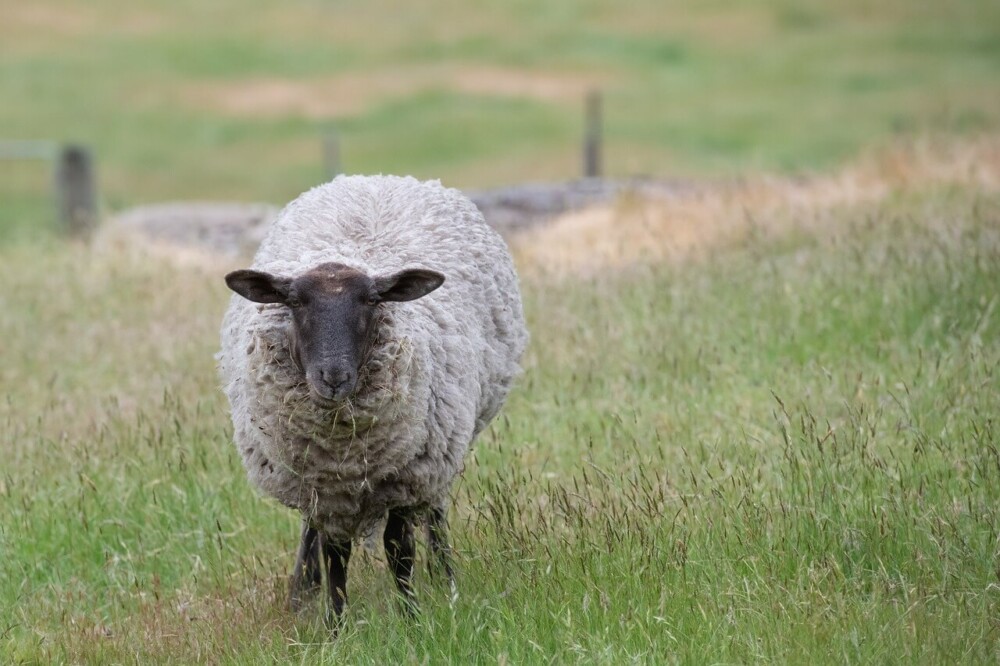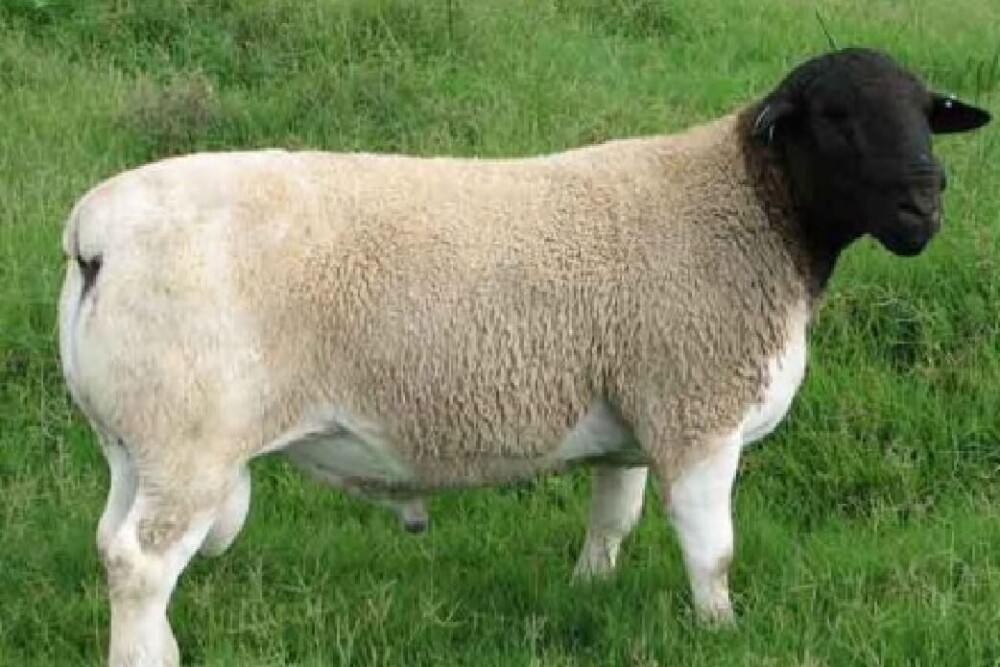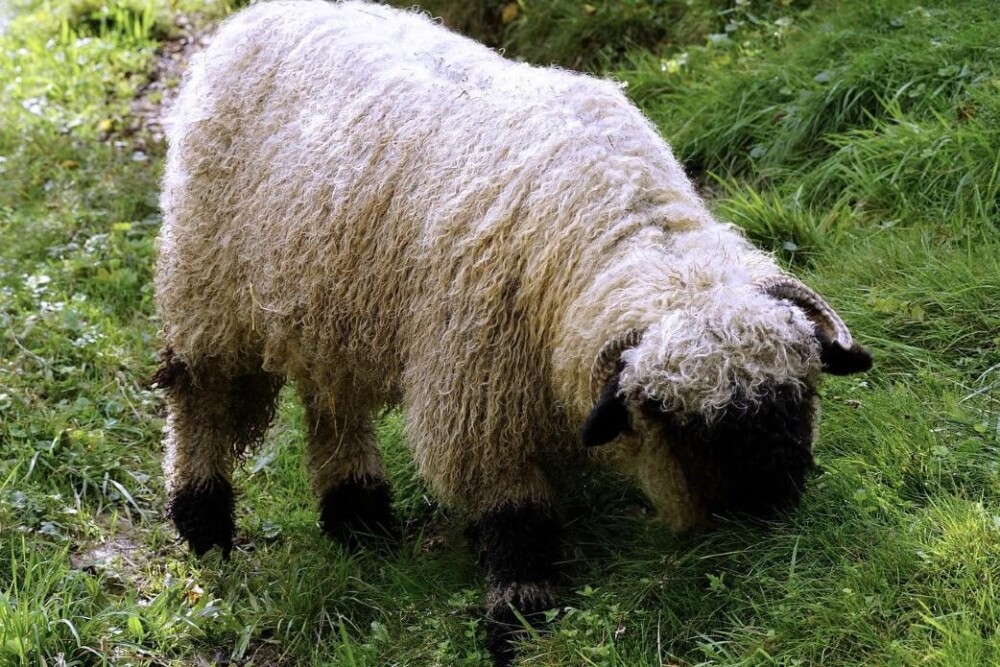Sheep come in various sizes and colors to suit any need or personal preference of the farmer or breeding operation. For most people, a field of white sheep is a common sight. But if you want something more unique, why not consider adding one of these solid black sheep breeds to your farm?
Solid black sheep were once considered extremely rare, but some breeds have since become much more common. They are still not kept as often as their solid white counterparts. Black wool is much harder to clean and almost impossible to dye but can be much cheaper and even more desirable to use for textiles that need natural black fibers.
Whether you are looking for a stunning breed of sheep to admire from a distance or want a utility breed that can provide products for your family, here is a shortlist of some of the best solid black sheep breeds available!
Black Katahdin Sheep
In the late 1950s, the original ancestors of the Katahdin sheep were imported into the United States as part of a breeding project to create a breed of meat sheep that did not require shearing. As a result of this breeding project, today’s modern Katahdin sheep are used solely for mutton production.
Katahdin sheep are genetically incapable of growing body fleece as other sheep do, and as a result, do not require annual shearing. This cuts down on their maintenance costs and allows them to live in hotter climates much easier than other breeds.
The Katahdin is a medium to large-sized breed with ewes reaching or exceeding 160 pounds (72kg) and rams reaching 250 pounds (113kg). They are usually found as polled stock, though it is not uncommon to see horned animals in some herds or genetic lines.
Katahdin is a slow-growing breed compared to some other meat breeds, but this extra time growing helps ensure a good bone structure and proper muscling throughout the sheep. Depending on your local market demands, outcrossing your Katahdin with other breeds can create more desirable mutton.
Katahdin can come in a wide range of colors and patterns, but the Black Katahdin is usually jet black all over its body, including the face, ears, and hooves.
Black Hawaiian Sheep
Commonly raised as a trophy breed on hunting ranches, the Black Hawaiian Sheep is an all-black variety with an excellent horn display. Said by some to be the melanistic color variation of the Mouflon sheep, the exact creation of the Black Hawaiian is largely unknown or only speculated on.
While the Black Hawaiian sheep is not considered a suitable choice for smaller mutton farms, it does offer high-quality lean meat with excellent muscle and bone structure. The flavor has been said to have a sweet and savory taste, with little to no gamey aftertaste like you would find in other wild or feral species.
The Black Hawaiian sheep is a medium-sized breed with ewes reaching 150 pounds (68kg) and rams reaching or exceeding 200 pounds (90kg). The horns are their most distinguishing feature, with rams displaying massive curled or Corsican-styled spreads.
This breed is considered a hair breed, and as such, does not produce wool. Instead, they will shed their undercoat annually, which helps them thrive in hot and dry climates while also eliminating the need for annual shearing.
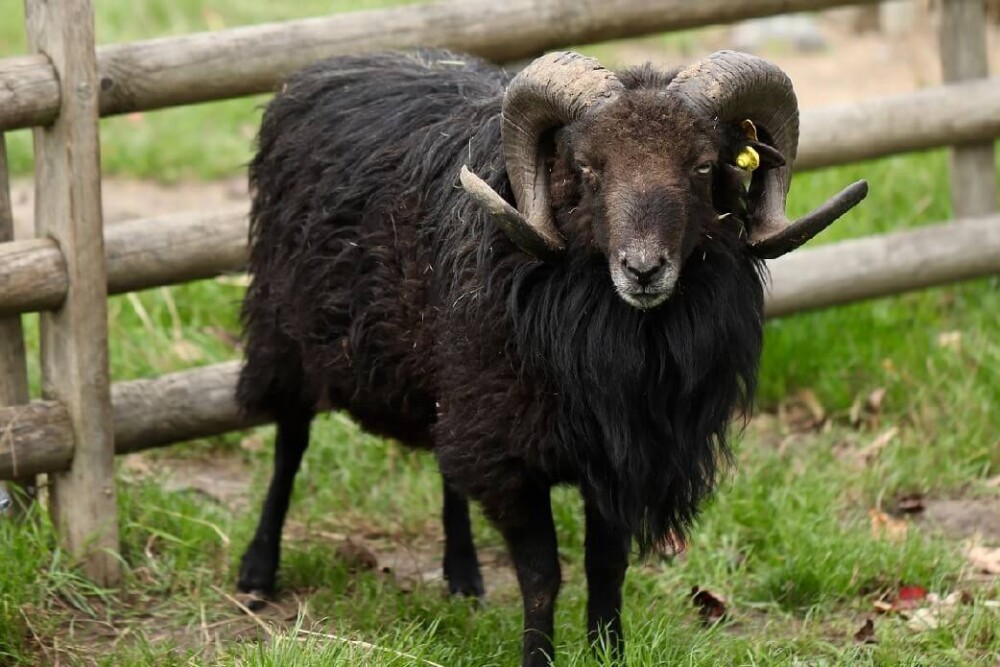
Black Welsh Mountain Sheep
Since the Middle Ages, the Black Welsh Mountain Sheep has been highly revered for the quality of its mutton as well as its fiber. A true dual-purpose exotic breed, the Black Welsh Mountain sheep, can be found in large numbers within the United States, the United Kingdom, and Ireland.
Considered a small to medium-sized breed, Black Welsh Mountain ewes, and rams both mature to a max of around 140 pounds (63kg). Their smaller size makes them much easier to handle and maintain for novice sheep owners.
Additionally, these sheep are extremely hardy and resistant to diseases. They are known for their ability to turn poor pasture into usable nutrients that can sustain them year-round in most areas. Lambing is generally problem-free, and the herd as a whole is very self-reliant when left at pasture.
Black Welsh Mountain sheep are mostly sought after for the quality of their jet black colored wool. The short fibers of their dense wool have been extensively used by hand spinners and wool-weavers worldwide.
Their meat has also been considered a premium delicacy in some parts of the world, making them an excellent choice for farms looking for an exotic breed to raise for meat.

Arapawa Island Sheep
Living as a mostly secluded feral breed of sheep since the 1800s, the Arapawa Island Sheep is considered a rare and endangered breed. While their exact origins are unknown, it has been speculated that the original sheep were survivors of a sunken whaling ship off the coast of New Zealand.
Raised mainly for preservation and ornamental purposes, Arapawa Island Sheep are also decent wool and meat producers for a small farm. Most commonly found in a solid black coloration, their wool is short and dense, making it a great choice for several small-scale textile operations and wool crafts.
The Arapawa Island ewe can reach 110 pounds (50kg) at maturity, and the ram can reach or exceed 120 pounds (54kg). Even though they are smaller than many other breeds, the Arapawa Island sheep can be tough to handle due to their feral lineage. This breed may also require stronger fencing than other breeds because of this.
Rams can display massive horns reaching a span of 3 feet (1m). Ewes are generally polled, but some individuals may also have small horns.
Hebridean Sheep
Originally from the western islands of Scotland, the four-horned Hebridean sheep is considered rare today. They are mostly kept for ornamental purposes, but you should not overlook their wool and milk capabilities.
Displaying a solid black body, the wool may turn gray or silver as the animal ages. You should shear them annually with an adult ewe producing 5 pounds (2.2kg) of fleece each time. The usable percentage of fiber is in the mid-range of around 50-60%.
Hebridean sheep are extremely self-reliant, with ewes rarely having issues with lambing. Twins and triplets are common in the breed, making it much easier for farms to earn an income from small flocks.
Adult Hebridean sheep can reach 130 pounds (59kg), with rams being slightly larger than ewes. Both rams and ewes can display horns, but most rams display four horns instead of the typical two.
While the Hebridean sheep are normally kept for their wool and meat, the ewes produce ample milk for their smaller size. They can easily feed their own lambs while still producing enough for your family to use.
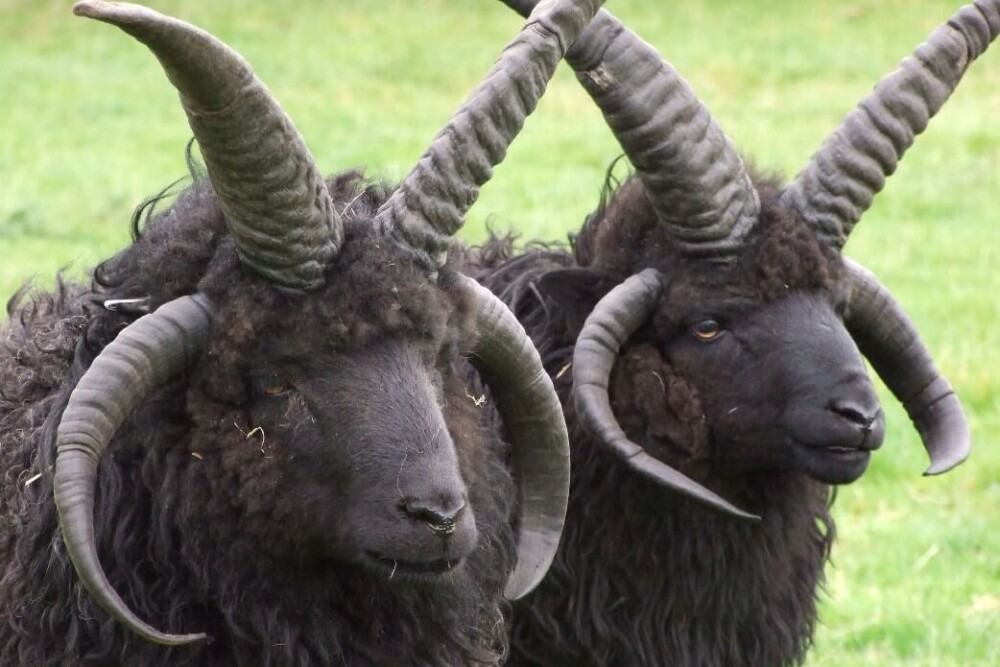
Suffolk Sheep
Recognized as a unique breed in the early 1800s, the extremely stocky Suffolk sheep is said to be the result of crossing Southdown and Norfolk breeds. The original Suffolk sheep were imported into the United States in 1886, and while they had a slow rise to popularity, by 1920, they had spread from the east to the west and were starting to be seen as one of the best dual-purpose breeds of sheep available at that time.
Suffolk sheep are often viewed as a meat-producing breed solely, boasting a flavorful carcass with a harvest weight of 120 pounds (54kg) or more. Mature live ewes can reach or exceed 250 pounds (113kg), and rams can reach an incredible 360 pounds (163kg) or more at maturity.
These sizable sheep are moderately good for their fiber production as well, with a single shearing produces up to 8 pounds (4kg) of fleece with a 62% usability rate.
They are white-bodied sheep with a full black face and ears, as well as black legs. Lambs are commonly born solid black but will usually develop their white fleece by weaning.
Hampshire Sheep
Originating in the United Kingdom in the late 1820s and first reported in the United States in 1840, this dual-purpose breed of sheep has quickly risen to fame worldwide as an exhibition breed and a utility breed.
Hampshire sheep are a large, naturally polled breed with a thick bone structure and a friendly disposition, making them a great choice for commercial producers and small breeders. Being a dual-purpose breed, the Hampshire sheep can produce up to 10 pounds of wool per shearing with a 60% usability rate.
Additionally, their large bone and lean meat offer a carcass that can reach 100-120 pounds (45-54kg) at harvest. Live weight for adult ewes is around 200 pounds (91kg) and roughly 250 pounds (113kg) for rams at maturity.
Their coloring is almost always seen as a white body with black faces and legs, which gives them a striking appearance when browsing in a field. Lambs are born slightly darker in color than their parents but will quickly lighten to take on their adult coloring.
Blackheaded Dorper Sheep
One of the best breeds for arid and harsh conditions, the Blackheaded Dorper is common throughout South Africa due to its ability to thrive in areas that have little to no rainfall.
While not as common as some other breeds in the United States, the Blackheaded Dorper is an attractive and desirable breed for both commercial and private producers to work with. They can turn poor pasture into usable nutrition while also maintaining excellent growth rates and high reproduction success.
Blackheaded Dorper sheep are viewed as a meat breed almost entirely, although they can produce small amounts of milk suitable for small farmers to make use of. Reaching a live weight of around 180 pounds (81kg) for ewes and up to 210 pounds (95kg) for rams at maturity, young Dorper can provide an 88-110 pound (40-50kg) carcass at slaughter.
Their unique coloring consists of a solid white body and legs, with a black head and neck. Lambs are usually born with the same coloring as their parents, although the black coloring in some lambs can extend into the shoulders and front legs depending on genetics.
Scottish Blackface Sheep
Bred since Medieval times, with the ancestors of this breed commonly kept in monasteries around Scotland and the United Kingdom, the Scottish Blackface Sheep is an ancient breed that has lasted for centuries.
Known almost entirely as a fiber-producing breed, these sheep are raised on both a commercial and small scale worldwide. Throughout the 1990s, the fiber from the Scottish Blackface alone made up nearly 40% of all sheep fiber processed in the United Kingdom.
Over time this number has dropped as more breeds are added to the fiber producing mix, but for farms wishing to focus on fiber production while maintaining a classic breed, the Scottish Blackface is an excellent choice.
This breed boasts thick spiraled horns in the rams and down curved horns in the ewes, and while almost all Scottish Blackface sheep are found horned, some producers are also working with polled varieties.
Adult ewes can easily reach or exceed 115 pounds (52kg), while rams can be around 150 pounds (68kg) at maturity. As their name suggests, the Scottish Blackface is a white-bodied sheep with a black face. Legs are often found solid black or in a black and white speckle. Lambs are born with snow-white fleece and jet black face and leg highlights.
Valais Blacknose Sheep
Arguably one of the most adorable sheep breeds in existence, the Valais Blacknose Sheep has been likened to plush toys and teddy bears. An extremely old breed first recorded in the 1400s, this Swiss breed is considered a dual-purpose sheep used for both fiber and meat.
Semen from pure Valais Blacknose sheep was first imported into the United States in 2016, with live animals imported in 2018. The Valais Blacknose has quickly turned into the most highly sought-after breed of sheep available today.
Their wool grows extremely fast, commonly reaching 12 inches in length annually. This means one sheep can provide wool twice a year, with each shearing producing around 4-5 pounds (1.8-2.2kg) of fiber.
As a medium-sized breed, the Valais Blacknose ewe can mature at 150 pounds (68kg) while the ram can reach or exceed 200 pounds (90kg). Attractive white bodies covered in long curly or crimped hairs draw the eye, while their jet black curl-covered faces and black-spotted knees add character and charm.
Lambs are covered in tightly curled wool from head to tail and mimic the adults’ coloring and patterns. Both ewes and rams should have tightly curled horns that sit close to the head. This breed is rarely found as a polled or hornless variety.
Conclusion
Whether your focus is on ornamental breeds or those bred for absolute utility, there is a black sheep right for you. Solid black sheep breeds are becoming more popular as time goes on. If you are a hand spinner or someone wanting a sheep that’s just a bit different from your neighbors, there is a solid black sheep breed that’s right for you.
My Essential Sheep Supplies
This list contains affiliate products. Affiliate products do not cost more but helps to support BestFarmAnimals and our goal to provide farm animal owners with accurate and helpful information.
This little giant bucket fits on a fence and this one’s easy to carry.
A sturdy dog collar is essential. Don’t do rope (they’ll break and tangle) or chain (injury!).
A Black Water Tub is way nicer than buckets that tip over. I like to get a 20 or 30-gallon in each pen so my goats have plenty of water, but you can get 100-gallons if you have a lot of sheep in one pen.
Loose minerals in a small bag or a Purina 50 lb bag, and a mineral feeder for free-choice is the best option. One side holds minerals, and the other holds baking soda. Don’t feed sheep goat minerals because it usually contains copper- something that is fatal to sheep.
Hoof trimmers are a necessity because you’ll need to trim your sheep’s hooves every few months. These are nice for the price.
Shearers like these aren’t too costly but do a decent job. Sheep wool jams normal shearers and once you are ready, I’d recommend the ones from Premier 1 Supplies.
Don’t make the mistake I made by waiting to order a drench gun before you need it. I was surprised by how often I use it. It helps with bloating, dehydration, and other ailments. Here’s a good drench, but you can also drench a bloat solution or water if dehydrated.
Digital Thermometor for when your lambs act sick. You’ll need to know if their temps are too low or too high so you can accurately diagnose the issues.
Vetericyn for wound care. It makes a big difference in a speedy recovery.
These heavy duty clips for fences, to clip ropes to collars, and a million other uses. They are stronger than carabeeners, which we broke a dozen of before switching to these.

